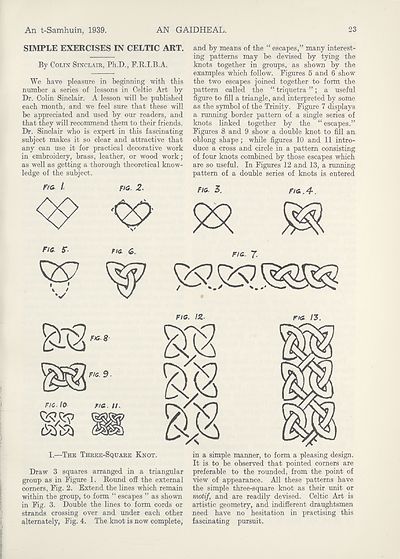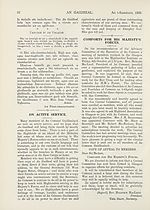An Comunn Gàidhealach Publications > Gaidheal > Volume 35, October 1939--September 1940
(31) Page 23
Download files
Complete book:
Individual page:
Thumbnail gallery: Grid view | List view

An t-Samhuin, 1939. AN GAIDHEAL.
23
SIMPLE EXERCISES IN CELTIC ART.
By Colin Sinclair, Ph.D., F.R.I.B.A.
We Have pleasure in beginning with this
number a series of lessons in Celtic Art by
Dr. Colin Sinclair. A lesson will be published
each month, and we feel sure that these will
be appreciated and used by our readers, and
that they will recommend them to their friends.
Dr. Sinclair who is expert in this fascinating
subject makes it so clear and attractive that
any can use it for practical decorative work
in embroidery, brass, leather, or wood work;
as well as getting a thorough theoretical know¬
ledge of the subject.
F/& I- FIG- 2.
'$$>
and by means of the “ escapes,” many interest¬
ing patterns may be devised by tying the
knots together in groups, as shown by the
examples which follow. Figures 5 and 6 show
the two escapes joined together to form the
pattern called the “• triquetra ”; a useful
figure to fill a triangle, and interpreted by some
as the symbol of the Trinity. Figure 7 displays
a running border pattern of a single series of
knots linked together by the “ escapes.”
Figures 8 and 9 show a double knot to fill an
oblong shape ; while figures 10 and 11 intro¬
duce a cross and circle in a pattern consisting
of four knots combined by those escapes which
are so useful. In Figures 12 and 13, a running
pattern of a double series of knots is entered
F/g. 5. fig . 4.
Fig. 5- fig
fig. 7
FIG. !Z. FIG /?.
I.—The Three-Square Knot.
Draw 3 squares arranged in a triangular
group as in Figure 1. Round off the external
corners, Fig. 2. Extend the lines which remain
within the group, to form “ escapes ” as shown
in Fig. 3. Double the lines to form cords or
strands crossing over and under each other
alternately, Fig. 4. The knot is now complete,
in a simple manner, to form a pleasing design.
It is to be observed that pointed corners are
preferable to the rounded, from the point of
view of appearance. All these patterns have
the simple three-square knot as their unit or
motif, and are readily devised. Celtic Art is
artistic geometry, and indifferent draughtsmen
need have no hesitation in practising this
fascinating pursuit.
23
SIMPLE EXERCISES IN CELTIC ART.
By Colin Sinclair, Ph.D., F.R.I.B.A.
We Have pleasure in beginning with this
number a series of lessons in Celtic Art by
Dr. Colin Sinclair. A lesson will be published
each month, and we feel sure that these will
be appreciated and used by our readers, and
that they will recommend them to their friends.
Dr. Sinclair who is expert in this fascinating
subject makes it so clear and attractive that
any can use it for practical decorative work
in embroidery, brass, leather, or wood work;
as well as getting a thorough theoretical know¬
ledge of the subject.
F/& I- FIG- 2.
'$$>
and by means of the “ escapes,” many interest¬
ing patterns may be devised by tying the
knots together in groups, as shown by the
examples which follow. Figures 5 and 6 show
the two escapes joined together to form the
pattern called the “• triquetra ”; a useful
figure to fill a triangle, and interpreted by some
as the symbol of the Trinity. Figure 7 displays
a running border pattern of a single series of
knots linked together by the “ escapes.”
Figures 8 and 9 show a double knot to fill an
oblong shape ; while figures 10 and 11 intro¬
duce a cross and circle in a pattern consisting
of four knots combined by those escapes which
are so useful. In Figures 12 and 13, a running
pattern of a double series of knots is entered
F/g. 5. fig . 4.
Fig. 5- fig
fig. 7
FIG. !Z. FIG /?.
I.—The Three-Square Knot.
Draw 3 squares arranged in a triangular
group as in Figure 1. Round off the external
corners, Fig. 2. Extend the lines which remain
within the group, to form “ escapes ” as shown
in Fig. 3. Double the lines to form cords or
strands crossing over and under each other
alternately, Fig. 4. The knot is now complete,
in a simple manner, to form a pleasing design.
It is to be observed that pointed corners are
preferable to the rounded, from the point of
view of appearance. All these patterns have
the simple three-square knot as their unit or
motif, and are readily devised. Celtic Art is
artistic geometry, and indifferent draughtsmen
need have no hesitation in practising this
fascinating pursuit.
Set display mode to:
![]() Universal Viewer |
Universal Viewer | ![]() Mirador |
Large image | Transcription
Mirador |
Large image | Transcription
| An Comunn Gàidhealach > An Comunn Gàidhealach Publications > Gaidheal > Volume 35, October 1939--September 1940 > (31) Page 23 |
|---|
| Permanent URL | https://digital.nls.uk/125143556 |
|---|
| Description | This contains items published by An Comunn, which are not specifically Mòd-related. It includes journals, annual reports and corporate documents, policy statements, educational resources and published plays and literature. It is arranged alphabetically by title. |
|---|
| Description | A collection of over 400 items published by An Comunn Gàidhealach, the organisation which promotes Gaelic language and culture and organises the Royal National Mòd. Dating from 1891 up to the present day, the collection includes journals and newspapers, annual reports, educational materials, national Mòd programmes, published Mòd literature and music. |
|---|---|
| Additional NLS resources: |
|

